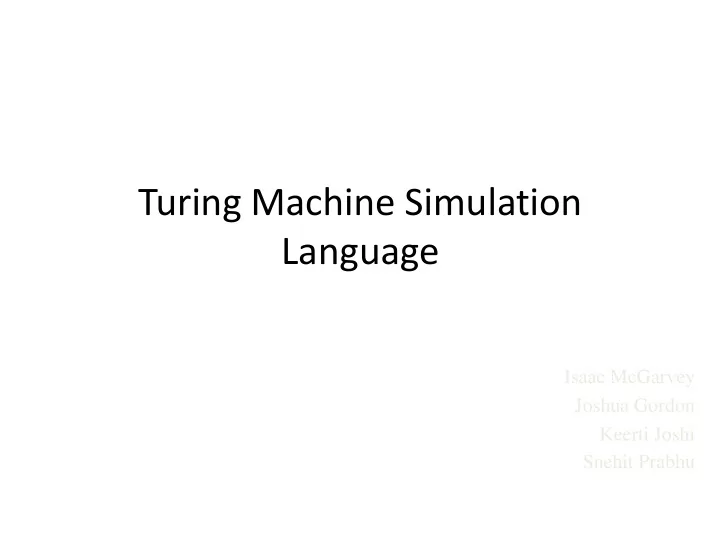

Turing Machine Simulation Language Isaac McGarvey Joshua Gordon Keerti Joshi Snehit Prabhu
Overview • What is a TM • Basic language Read/Write, Moving along tape head, Control constructs, Arbitrary tape alphabet. • Scope of Language – Single tape datastructure – Single pass compilation without look-ahead.
Overview • Evolution of TMSL – Started with configuration file syndrome – Moved on to an ambitious high-level language plan – Converged on low-level scripting language with a tractable mapping from script to TM constructs. • Limitations – No function definitions or code reusability. – No arithmetic. – No variables.
Language Overview • Grammar: – Our programs are composed of symbols and statements – A symbol list • which specifies the characters which may be written to and read from the tape (in addition to the special blank character) – A statement list • Which specifies control flow and commands • Statements are generally of two types: – Atomics (e.g., left, right, write, exit) – Composites (e.g., if, while, until, unless) • Composites are simply statements which contain lists of statements within their definition, e.g. – UNLESS LPAREN symbol_list RPARENLBRACE stmt_list RBRACE
Writing a program: Unsigned subtraction • 0,1 /*alphabet specification */ • while (1) { • if (1) { • write _ • right • while (1) { • right • } • Sample Input : 1111011_ _ _ • Output : _ _ 11000 _ _ _ • Demo?
Implementation • Machine Simulator – 2 scanners & parsers – Following transitions stored in list – Dynamically growing input tape
Implementation • Compiler – Scanner & parser – AST types: statements, symbols – Code generation • Single pass: minimal semantic error checking • Translating statements into states and transitions • Bookkeeping: assigning state numbers to statements
Implementation
Summary and Lessons Learned Language Design concepts • Even out work through the semester • Test cases (Regression suite) • Good experience with the language • Its fun to build your own compiler!
Recommend
More recommend